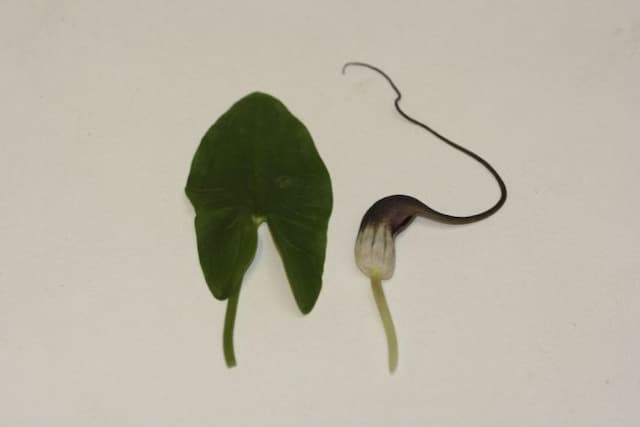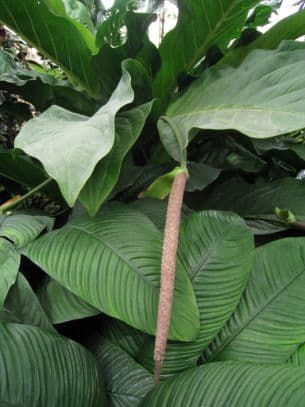Peace lily 'Mauna Loa' Spathiphyllum 'Mauna Loa'



ABOUT
Spathiphyllum 'Mauna Loa' is a hybrid cultivar of the peace lily, Spathiphyllum. It is known for its large, glossy, dark green leaves and its large, long-lasting white flowers.
The leaves of 'Mauna Loa' are typically arranged in a rosette pattern and can grow up to 2 feet in length. The flowers are borne on tall, slender spikes and are typically 6-8 inches long. The flowers are typically white, but some cultivars may have cream or pale green blooms.
'Mauna Loa' is a popular indoor plant, known for its low maintenance, and ability to improve air quality by removing toxins from the air. It's also a good choice for those who have low light conditions in their homes. It is tolerant of a wide range of temperatures and humidity levels, and can be grown in a variety of potting soils.
About this plant
 Names
NamesFamily
Araceae
Synonyms
Peace Lily 'Mauna Loa', Spathe flower 'Mauna Loa', Mauna Loa Peace lily, White Sails 'Mauna Loa'
Common names
Hydnostachyon, Massowia, Spathiphyllopsis, Amomophyllum, Leucochlamys
 Toxicity
ToxicityTo humans
The leaves and flowers of the plant contain small amounts of calcium oxalate crystals, which can cause skin irritation and oral pain if ingested. Additionally, the flowers and leaves can cause skin irritation for people with sensitive skin.
To pets
Spathiphyllum 'Mauna Loa' is considered to be toxic to animals when ingested.
Consuming any part of the plant can cause oral pain, excessive drooling, vomiting and difficulty swallowing. If you have pets in your home, it is recommended to keep this plant out of reach of them.
 Characteristics
CharacteristicsLife cycle
Perennials
Foliage type
Evergreen
Color of leaves
Green
Flower color
White
Height
Up to 2 feet
Spread
Up to 2 feet
Plant type
Herb
Hardiness zones
10
Native area
Central and South America
Benefits
 General Benefits
General BenefitsSpathiphyllum 'Mauna Loa' is a relatively low-maintenance plant that is easy to care for. It can tolerate a wide range of temperatures and humidity levels, and it does not require a lot of watering or fertilizing;
The white flowers of Spathiphyllum 'Mauna Loa' can last for several weeks, making it a great choice for a long-lasting floral display;
Spathiphyllum 'Mauna Loa' has attractive glossy green leaves that can reach up to 2 ft long and large, long-lasting white flowers which makes it a great addition to any room;
Peace lily is known to release moisture into the air which can improve the humidity level in a room which can be beneficial for people with dry skin, asthma, or allergies. Medical Properties
Medical PropertiesThis plant is not used for medical purposes.
 Air-purifying Qualities
Air-purifying QualitiesThe peace lily is known for its ability to remove toxins from the air, including formaldehyde, benzene, and trichloroethylene. This makes it a great choice for indoor spaces where air quality is a concern.
 Other Uses
Other UsesThe plant is a great choice for a houseplant as it is easy to care for and can thrive in low light areas. It produces beautiful white flowers and dark green foliage, making it a great addition to any home;
Spathiphyllum ‘Mauna Loa’ makes a great gift for any occasion as it is known for its beauty and long-lasting foliage;
It is a great choice for a decorative plant as its white flowers and dark green foliage make it a great addition to any room.
Interesting Facts
 Feng Shui
Feng ShuiIn feng shui, Spathiphyllum 'Mauna Loa' is believed to bring good luck and positive energy to a space.
It is often placed in the east or southeast areas of a room, which are associated with the Wood element and the family and health aspects of feng shui. Placing the plant in the bedroom is also believed to promote peaceful sleep and improve the overall energy of the room. Zodiac Sign Compitability
Zodiac Sign CompitabilityPeace lily is considered to be compatible with all zodiac signs, as it is associated with peace, harmony, and balance.
 Plant Symbolism
Plant SymbolismSpathiphyllum 'Mauna Loa' is often associated with peace and tranquility, making it a popular choice for spaces where relaxation and calm are desired.
The white flowers are also associated with purity, innocence, and spiritual growth.
The large leaves of 'Mauna Loa' are associated with abundance and wealth.
 Water
WaterSpathiphyllum 'Mauna Loa' should be watered once a week, giving it enough water to thoroughly moisten the soil.
To do this, fill a watering can with lukewarm water and slowly pour it over the soil until it starts to drip from the drainage holes in the bottom of the pot. Allow the excess water to drain away into the saucer beneath and discard it afterwards.
Avoid overwatering, as this can cause the leaves to yellow and the roots to rot. Light
LightThe Spathiphyllum 'Mauna Loa' prefers bright indirect light to thrive.
It can tolerate shade, but should be kept away from direct sunlight to prevent foliage burn.
It is best to place the plant near an east or west facing window to receive the right amount of light. For best results, the plant should receive at least 4 hours of bright indirect light each day. Temperature
TemperatureSpathiphyllum 'Mauna Loa' is best suited to warm temperatures between 65-80°F. It should not be exposed to temperatures below 50°F as this may cause damage to the plant.
 Pruning
PruningPruning this plant is a great way to keep it looking its best and promote healthy growth. When pruning Spathiphyllum ‘Mauna Loa’, it is important to remove any dead, diseased, or damaged leaves and stems. This will help prevent the spread of disease and keep the plant looking its best. Prune out any stems that have become too tall and thin, as this can weaken the plant. Pinching out the tips of the stems will encourage bushier growth, while cutting off any flower stems will encourage more flowers to bloom.
 Cleaning
CleaningAs needed
 Soil
SoilSpathiphyllum 'Mauna Loa' prefers a soil with a slightly acidic to neutral pH of 6.0 to 7.0.
The soil should be well-draining and rich in organic matter, such as peat moss, compost, or aged manure. The soil should be kept evenly moist, but not soggy.
A well-draining potting mix that contains some sand or perlite is ideal. Repotting
RepottingSpathiphyllum 'Mauna Loa' should be repotted every 2-3 years.
The best time to repot is during the spring, when temperatures are mild and the plant is actively growing. When repotting, use fresh potting soil and a container one size larger than the current pot.
Be sure to loosen the roots of the plant before placing it in its new container. Humidity & Misting
Humidity & MistingThe ideal humidity level for Spathiphyllum 'Mauna Loa' is between 60-70%.
You should also provide good air circulation to help the plant thrive. If you live in a dry climate, you may want to consider setting up a humidifier or misting the leaves regularly to keep the humidity level up. Suitable locations
Suitable locationsIndoor
All year round
Outdoor
It is a popular houseplant, but it can also be grown outdoors in warm climates.
Find a suitable location in your garden for the plant. Spathiphyllum 'Mauna Loa' prefer a location that gets partial shade and has well-draining soil. Space the plants at least 20 inches apart to give them room to grow.
Water the plants regularly, but be careful not to overwater as this can cause the roots to rot.
Feed the plants with a balanced fertilizer once a month during the growing season.
Prune the plants regularly to maintain a desired shape and size.
Protect the plants from extreme temperatures, such as frost or strong heat, by covering them with a blanket or shade cloth.Hardiness zone
11 - 12 USDA
 Life cycle
Life cycleThe life of the plant start with germination. Once the roots have formed, the cutting can be potted in soil.
Spathiphyllum ‘Mauna Loa’ prefers a warm, humid environment with indirect light. It should be watered regularly, allowing the soil to dry out slightly between waterings. Fertilize monthly during the growing season. Pruning can be done as needed to maintain a desired size or shape.
Spathiphyllum ‘Mauna Loa’ produces white, spathulate flowers that are borne on upright stems. The flowers are followed by green berries that will eventually turn brown and then black when ripe.
Spathiphyllum ‘Mauna Loa’ will enter a dormant period in the winter months when temperatures are cooler. During this time, reduce watering and fertilizing and the plant may die back partially. Once temperatures warm up in the spring, the plant will begin to regrow. Propogation
PropogationPropogation time
Spring - early summer
By DIVISION:
This method involves carefully dividing an existing plant into two or more smaller plants. To do this, carefully dig up the plant, separate it into two or more clumps, and replant each clump in its own container with fresh soil.
By STEM CUTTINGS:
This method involves taking a cutting from an existing plant and rooting it in water or soil. To take a cutting, use a sharp, clean knife or scissors to cut off a stem with a few leaves attached. Place the cutting in a container of water and wait for it to form roots, or place it in a pot filled with a moistened soil mix.
No matter which method you choose, it is important to provide the right environmental conditions for the plant to thrive. Spathiphyllum 'Mauna Loa' prefers moist, well-drained soil and bright, indirect sunlight.
 Pests
PestsSpider mite, Whitefly, Thrips, Scale insects, Mealybug, Aphid
 Diseases
DiseasesRoot Rot, Powdery mildew, Leaf spot









